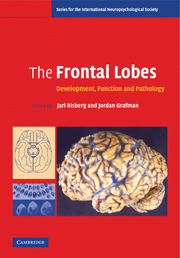Book contents
- Frontmatter
- Contents
- Contributors
- From the series editor
- Introduction
- 1 Evolutionary aspects on the frontal lobes
- 2 Organization of the principal pathways of prefrontal lateral, medial, and orbitofrontal cortices in primates and implications for their collaborative interaction in executive functions
- 3 Human prefrontal cortex: processes and representations
- 4 A microcircuit model of prefrontal functions: ying and yang of reverberatory neurodynamics in cognition
- 5 Prefrontal cortex: typical and atypical development
- 6 Case studies of focal prefrontal lesions in man
- 7 Left prefrontal function and semantic organization during encoding and retrieval in healthy and psychiatric populations
- 8 Clinical symptoms and neuropathology in organic dementing disorders affecting the frontal lobes
- Index
- Plate section
- References
3 - Human prefrontal cortex: processes and representations
Published online by Cambridge University Press: 11 September 2009
- Frontmatter
- Contents
- Contributors
- From the series editor
- Introduction
- 1 Evolutionary aspects on the frontal lobes
- 2 Organization of the principal pathways of prefrontal lateral, medial, and orbitofrontal cortices in primates and implications for their collaborative interaction in executive functions
- 3 Human prefrontal cortex: processes and representations
- 4 A microcircuit model of prefrontal functions: ying and yang of reverberatory neurodynamics in cognition
- 5 Prefrontal cortex: typical and atypical development
- 6 Case studies of focal prefrontal lesions in man
- 7 Left prefrontal function and semantic organization during encoding and retrieval in healthy and psychiatric populations
- 8 Clinical symptoms and neuropathology in organic dementing disorders affecting the frontal lobes
- Index
- Plate section
- References
Summary
Introduction
The purpose of this chapter is to familiarize you with a variety of contemporary approaches that place the function(s) of the prefrontal cortex in a cognitive context. Obviously, without a context, interpreting findings from single research studies can be difficult. In addition, without a context, it can be difficult to know whether a specific line of research is clearly verifying or rejecting a proposed prefrontal cortex (PFC) function. Finally, as with posterior cerebral cortex functions, it is much easier to see how a particular cognitive component functions within a system if you have an overall context to place that component in. The broad cognitive context that needs to be articulated is one that explains the cognitive commonality between, and the neural mechanisms shared by, higher cognitive functions. Through evolution, humans have acquired “higher” cognitive skills such as language, abstract reasoning, planning, and complex social behavior. Evidence from lesion and neuroimaging research indicates that the PFC mediates the key components composing these higher cognitive skills. A number of theories have been proposed for how the PFC might achieve this. Although many of these theories focus on the types of “processes” that the PFC carries out, an alternative point of view emphasizes the nature of long-term representations stored in the PFC. This chapter reviews both of these approaches although I place more weight on the representational approach, partly because it has been dominated by the process approach to date and partly because it is the view I espouse.
- Type
- Chapter
- Information
- The Frontal LobesDevelopment, Function and Pathology, pp. 69 - 91Publisher: Cambridge University PressPrint publication year: 2006
References
- 2
- Cited by



